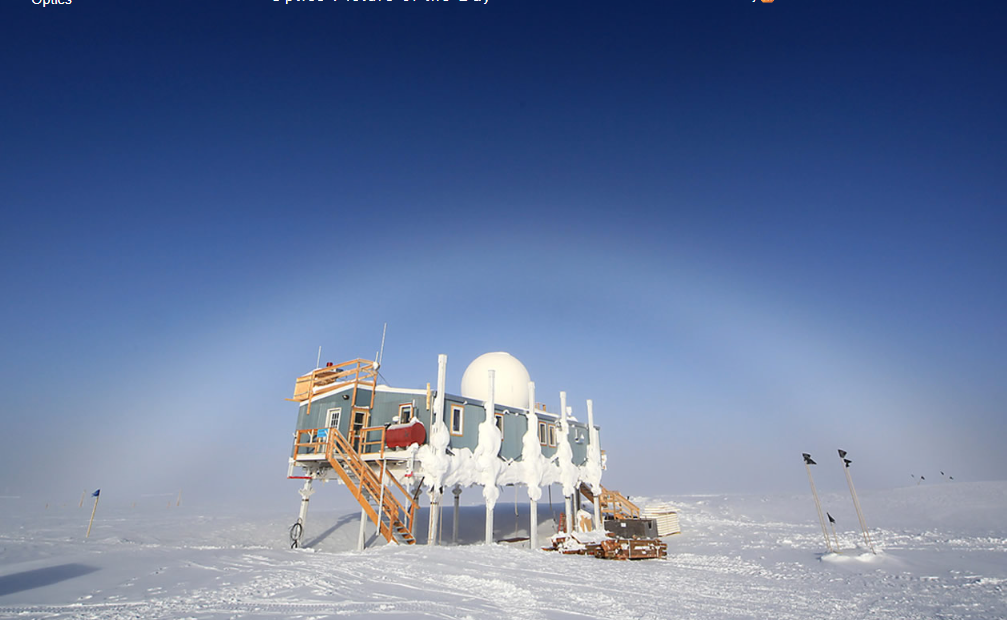OPOD - Fogbow, Greenland
OPOD - Fogbow, Greenland: Exploring the Enigmatic Optical Phenomenon
Welcome to a captivating exploration of a mesmerizing atmospheric optics phenomenon known as the fogbow. In this article, we will delve into the intriguing world of fogbows, with a specific focus on a stunning example observed over the 'Big House' at Summit Station in the heart of the Greenland Ice Cap. Let's embark on this journey of discovery and unravel the secrets behind the ethereal beauty of fogbows.
Fogbows, much like their more famous counterpart rainbows, are created by sunlight interacting with water droplets suspended in the atmosphere. However, there are fascinating distinctions that set fogbows apart. In the frigid temperatures of the ice cap, these water droplets become supercooled, existing below the freezing point of water. For the phase change from supercooled water to ice to occur, nuclei are required as a foundation for crystal growth. Unfortunately, the pure air above the ice sheet lacks these nuclei, making fogbow formation an exceptional occurrence.
The formation process of fogbows closely resembles that of rainbows. As sunlight passes through near-spherical water droplets, it undergoes refraction, internal reflection, and refraction once again upon exiting the droplet. The key differentiating factor lies in the size of the droplets themselves. Fog and mist droplets range from 1 to 100 microns in diameter, making them relatively large compared to the wavelengths of visible light. This size differential amplifies diffraction and interference effects, resulting in a broadening of colors and an overlapping of hues that ultimately gives rise to an almost white appearance.
To truly appreciate the enchanting allure of fogbows, it is essential to witness them firsthand. The image captured by Ed Stockard showcases a fogbow gracefully arching over the 'Big House' at Summit Station, situated amidst the vast expanse of the Greenland Ice Cap. This ethereal phenomenon serves as a testament to the awe-inspiring beauty that can be found in the most remote and pristine corners of our planet.
While fogbows are a captivating spectacle, it is important to note that this article has been automatically converted from the old site, and as such, may not fully capture the intended essence of the original content. However, fear not, for we are here to provide you with a comprehensive and detailed exploration of fogbows and their mesmerizing characteristics.
To deepen our understanding of fogbows, let us further explore the factors that contribute to their formation. The size of the water droplets plays a crucial role, as larger droplets allow for more pronounced diffraction and interference effects. Additionally, the purity of the air and the absence of nuclei present a unique challenge for the formation of fogbows over the Greenland Ice Cap. The scarcity of suitable nuclei necessitates extremely low temperatures, typically below approximately -40 degrees Celsius, for homogeneous nucleation to occur.
Furthermore, it is worth mentioning that fogbows possess an inherent delicacy and evanescence. Their appearance is contingent upon specific atmospheric conditions, including the presence of fog or mist and the angle of sunlight. Consequently, witnessing a fogbow is a rare and fleeting experience that adds to its allure.
In conclusion, fogbows represent a captivating optical phenomenon that emerges from the interplay between sunlight and supercooled water droplets suspended in the atmosphere. With their broader spectrum of colors and overlapping hues, fogbows offer a unique visual spectacle that stands in stark contrast to the vibrant and distinct hues of rainbows. The fogbow observed over the 'Big House' at Summit Station in Greenland exemplifies the extraordinary beauty that can be found in remote and icy landscapes. So, keep your eyes peeled for these enchanting apparitions and embrace the magic they bring to our skies.

Fogbow over the 'Big House' - Summit Station at the centre of the Greenland Ice Cap. Drill down through 2 miles of ice to reach rock. Image by Ed Stockard (photostream). Image ©Ed Stockard

The fogbow is created by sun rays passing through small water droplets. At ice cap temperatures the water drops are unstable, they are supercooled below zero Celsius. The phase change to the stable state, ice, needs nuclei on which crystals can grow. These are lacking in the pure air over the ice sheet. Homogeneous nucleation, without nuclei, usually requires temperatures below about -40 Celsius.
Fogbows form similarly to rainbows. Light enters a near spherical water drop, is refracted, a small fraction is internally reflected from the opposite side and is refracted again as it leaves.
The key difference from rainbow formation is drop size. Fog and mist droplets (1-100 micron diameter) are fairly large compared to the wavelengths of visible light but small enough that diffraction and interference effects become more pronounced. The rainbow of well-defined sharp colours is considerably broadened and colours overlap to give almost white.
Note: this article has been automatically converted from the old site and may not appear as intended. You can find the original article here.
Reference Atmospheric Optics
If you use any of the definitions, information, or data presented on Atmospheric Optics, please copy the link or reference below to properly credit us as the reference source. Thank you!
-
<a href="https://atoptics.co.uk/blog/opod-fogbow-greenland/">OPOD - Fogbow, Greenland</a>
-
"OPOD - Fogbow, Greenland". Atmospheric Optics. Accessed on November 26, 2024. https://atoptics.co.uk/blog/opod-fogbow-greenland/.
-
"OPOD - Fogbow, Greenland". Atmospheric Optics, https://atoptics.co.uk/blog/opod-fogbow-greenland/. Accessed 26 November, 2024
-
OPOD - Fogbow, Greenland. Atmospheric Optics. Retrieved from https://atoptics.co.uk/blog/opod-fogbow-greenland/.